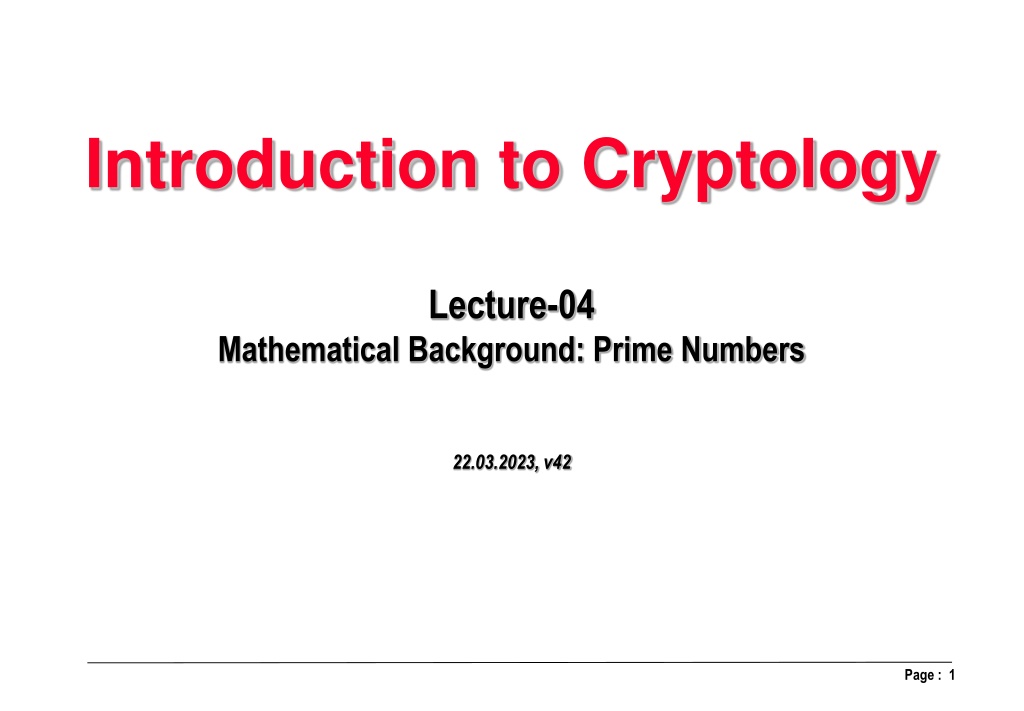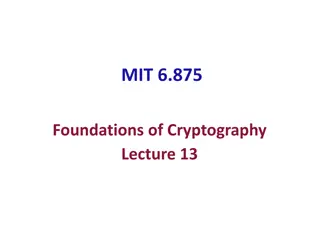Understanding Prime Numbers in Cryptology: Math Background & Tests
Delve into the significance of prime numbers in cryptology with this lecture covering prime number theory, generation, and methods for finding probable and provable primes using algorithms like Fermat's and Miller's tests. Discover the role of prime numbers in generating finite fields and explore the complexity of prime factorization.
Download Presentation

Please find below an Image/Link to download the presentation.
The content on the website is provided AS IS for your information and personal use only. It may not be sold, licensed, or shared on other websites without obtaining consent from the author. Download presentation by click this link. If you encounter any issues during the download, it is possible that the publisher has removed the file from their server.
E N D
Presentation Transcript
Introduction to Cryptology Lecture-04 Mathematical Background: Prime Numbers 22.03.2023, v42 Page : 1
Mathematical Background In Discrete Mathematics, Number Theory Outlines Euclidean Algorithm, Remainder Greatest Common Divisor (gcd) part 1 Group Theory, Rings, Finite Fields Element s Order, Euler Theorem part 2 Prime Numbers Prime Number Generation part 3 Extension Fields part 4 Page : 2
Prime Numbers Primes are necessary to generate finite fields (GF) Prime numbers like : 2, 3, 5, 7, ..13 ,17 ,19 .. A prime only divisible by 1 or itself How many primes do exist between 1 and n? The number of such primes (n) is found to be approximated by: n (Tchebycheff Theorem) (First indicated by Gauss without proof) = lim (n) n ln( ) n Where; ln =loge js the natural logarithm, e = 1/n! (for n=1 to ) = 2.718.. (Euler s number) Or Example: The probability that a randomly picked up integer r is a prime number for 1 r n= 10100 is: ( ) n n 1 1 10100 = ( n ) Pr(r = prime) = ln( ) n 230 Page : 3
Sample prime numbers To get a provably prime p, needs exhaustive factorization of p : Worst case complexity O( p) List of Primes up to 4483 Page : 4
How to Find Probably-Primes ? Based on: Fermat s Theorem If p is a prime number then for any 1 < b < p p-1 b = 1 (mod p) Primality test: If an integer m fulfils Fermat theorem condition for some random integer b, That is; if bm-1= 1 (mod m) then m is called a pseudoprime to the base b. The probability that m is not a prime is 2-1 Therefore, for t such successful random tests, this probability is 2 -t Miller test : an improved test used to check pseudo-primality based on Fermat theorem Page : 5
How to Find Probable Primes? Use Miller Test m is odd Widespread faster primality test algorithm Search for s and Q such that m-1= 2s Q, Q is odd Compute yes no yes no yes m is a strong pseudoprime for the base b no Miller test based on Fermat theorem. For t independent random choices of b and successful tests, the probability that m is not a prime is roughly < 4-t m is not a prime Page : 6
How to Find Provably-Primes ? Based on Pocklington s Theorem (1916) Pocklington s Theorem Let n = 1 + F R and let F = q1... qtbe the distinct prime factors of F. If there exists an integer a such that all the following three conditions hold, 1. an-1 1 (mod n) 2. for all qis where i = 1 .. t, gcd (a(n-1)/qi - 1, n) = 1, 3. if F > n, then n is prime. The probability that a randomly selected a satisfies Pocklington s Theorem is (1 1/qi) Example: n = 2 ( 3 11 ) + 1 = 67, F = 3 x 11 and R=2. Is 67 a prime? Proof: select a=2 ( 1 < a < 67 ) 1. 267-1= 1 mod 67 ( or in Z67 ) is true 2. gcd ( 2(67-1)/ 3 1 , 67 ) = gcd ( 222 1 , 67 ) = 1 is true (selecting a=2) gcd ( 2(67-1)/ 11 1, 67 ) = gcd ( 26 1 , 67 ) = 1 is true 3. F = 3 x 11 > 67 => 33 > 8.18 is true => 67 is prime By selecting R=3 => n = 3 (3x11) +1 = 100. Is 100 a prime?. Check: condition 1: 2100-1= 299=88 1 (mod 100) is not true, condition 2 : is not true => 100 is not a prime ! Page : 7
Setting up GF(67) Algebra Some facts in GF(67) Number of invertible elements in GF(67) is Euler function (67) = (67-1)=66 = 2.3.11 The possible multiplicative orders in GF(67) are the divisors of 66 namely 1, 2, 3, 6,11,22,33,66 Notice: Prime factors of 66 are known when constructing the prime 67 = 2 x (3 x 11) + 1 Number of elements with order 1 is (1) = 1 Number of elements with order 33 is (33) = (3x11)=(3-1) (11-1)= 20 Number of elements with order 66 is (66) = (2x3x11)=(2-1)(3-1)(11-1)= 20 Example: order of 11: 111= 11 1, 112= -13 1, 113=-9 1, 116=14, 1111=30, 1122=29 1, 1133=29x11=-1 1 => order of 11 is 66. Now we know that the order of 11 is 66 , thus Ord (11i) = 66 / gcd (66,i). by selecting i=2 => order [ 112=54 ]= 66/2=33. by selecting i=5 => order [115=50]=66/1=66. by selecting i=6 => order [116=14]= 66/6=11. 1. 2. 3. 66 = 2.3.11 4. Mult. Inv of 31 in GF( 67) =13 a1-qa2 b1-qb2 n1 n2 a1 b1 a2 b2 q r computation 67 1 0 0 1 2 5 67/31 =2 + 5/67 31 0-2x1 -2 1-6x-2 13 31/5= 6 +1/5 31 5 0 1 1 6 1 --- 5 1 1 -2 5 0 5/1=5+ 0/1 Page : 8
Special Useful Primes Strong Primes A prime number p is said to be a strong prime if (p-1) has a large prime factor q, in best case p -1 = 2q (that is p=2q+1) Example: p=23, p-1 = 22 = 2 x 11, that is q=11. k time 1 s Mersenn Primes Are primes having the form 2k-1 in binary form k 1 s 1111 1111 Known Primes for k= 2, 3, 5, 7, 13, 17 .. 82 589 933 (status 2018) k-1 time 0 s Primes in the form 2k+ 1 in binary form 10000 0001, (k+1 bits) Are primes with practical importance known for k= 0, 1, 2, 4, 8, 16 Example: (216+1) is a prime used in practical crypto-systems Page : 9
Special Useful Primes Strong Primes A prime number p is said to be a strong prime if (p-1) has a large prime factor q, in best case p -1 = 2q Example: p=23, p-1 = 22 = 2 x 11, that is q=11. k time 1 s Mersenn Primes Are primes having the form 2k-1 in binary form k 1 s 1111 1111 Known Primes for k= 2, 3, 5, 7, 13, 17 .. 82 589 933 (status 2018) k-1 time 0 s Primes in the form 2k+ 1 in binary form 10000 0001, (k+1 bits) Are primes with practical importance known for k= 0, 1, 2, 4, 8, 16 Example: (216+1) is a prime used in practical crypto-systems Page : 10
Special Useful Primes Fermat Primes 22n+1 Having the form: Example: exist for: n 0,1,2,3,4,? Permutable prime is a prime with at least two distinct digits which remains prime on every rearrangement (permutation) of the digits: Example: 337, 373, 733 are all primes (in the decimal system, base 10) Palindromic Prime Example of a pyramid of palindromic primes: 2 30203 133020331 1713302033171 12171330203317121 151217133020331712151 1815121713302033171215181 16181512171330203317121518161 331618151217133020331712151816133 Page : 11
Hardware Complexity of Modular Multipliers with Special Primes Example when using Mersenn prime as modulus: Hardware implementation - If the modulus is a Mersenn p where p = 2k -1 then 2k-1 = 0 mod p, therefore 2k = 1 mod p k-bits X2 k-bits X1 X1 X2 -An integer X having 2k-bits can be written as: . k-bits k-bits multiplier * X = a + 2kb 2k b a 2k-bits X k-bits 2k B k-bits A X1X2mod (2k 1) Then: X mod p = a + b The modular product of X1 X2 (whereX1, X2are k-bits each): + k-bits adder If X1 X2= A + 2kB ( the product has 2k-bits) mod (2k 1) Then ( X1X2) mod p = A + B No need for division to compute the remainder modulo p = 2k -1 X1X2mod (2k 1) Page : 12
Special Practically Standardized Primes !!!! Primes represent still a big scientific mystery with serious impact on mdern everday s life!!!!! The five NIST primes are: p192= 2192 264 1 p256= 2256 2244+ 2192+ 296 1 p521= 2521 1 The largest prime p521, is a Mersenne prime, and the rest are generalized Mersenne primes. Except for p521, the exponents of 2 in the NIST primes are all multiples of 32 or 64. This leads to efficient tricks for arithmetic modulo such primes executed on 32-bit or 64-bit computers. p224= 2224 296+ 1 p384= 2384 2128 296+ 232 1 secp256k1 is used for Bitcoin operating over GF(p) Where p = FFFFFFFF FFFFFFFF FFFFFFFF FFFFFFFF FFFFFFFF FFFFFFFF FFFFFFFE FFFFFC2F (in HEX) p = 2256 - 232 - 29 - 28 - 27 - 26 - 24 - 1 Golden primes and Goldilocks for Elliptic-Curve systems ED448: (by Mike Hamburg) The prime in this case is p = 2448 2224 1 called the Goldilocks prime. In the form p = 1 where =2224 . The middle term 2224 is just the right size. Because 224 = 32*7 = 28*8 = 56*4, this prime supports fast arithmetic in radix 228 or 232 (on 32-bit machines) or 256 (on 64-bit machines). Page : 13
Modular Multiplication Complexity for ED448 modulus Golden primes and Goldilocks for Elliptic-Curve ED448: (by Mike Hamburg) The prime p = 2448 2224 1 is used as modulus in GF(p). Where p = 1 and =2224 As p is the modulus, p = 1 = 0 therefore => = + 1 and =2224 X1 and X2 are two integers each having 448-bits and can be describes as follows: 224-bits 224-bits a 2224 b X1 = (a + b) a and b are two 224-bits integers, 224-bits 224-bits X2 = (c + d) c and d are two 224-bits integers c 2224d The product of the two 442-bit integers X1 X2 mod p can be computed as follows: X1 X2 = (a + b ) (c + d ) = ac + (ad +bc) + bd 2 X1 X2mod p ac + (ad +bc) + bd 2mod p ac + (ad +bc) + bd ( + 1) ac + bd + (ad + bc + bd) ac + bd + (ad + bc + bd +ac-ac) ac + bd + (ad + bc + bd + ac - ac) X1 X2mod p (ac + bd ) + [ (a + b) (c + d) ac ] Complexity: four 224-bits multiplications and four 224-bit additions/subtractions Page : 14
Example: Tricky ED448 Modular Multiplier Construction: (by Mike Hamburg) The prime p = 2448 2224 1 is used as modulus. Where p = 1 and =2224 Constructing a computation structure for: X1 X2mod p (ac + bd ) + [ (a + b) (c + d) ac ] m1 m2 X1 X2 224-bits 224-bits 224-bits 224-bits b d a c X1 X2 + + * + + _ X1X2mod (2448 2224 1 ) m1 m2 448-bits X1X2mod (2448 2224 1 ) Page : 15























